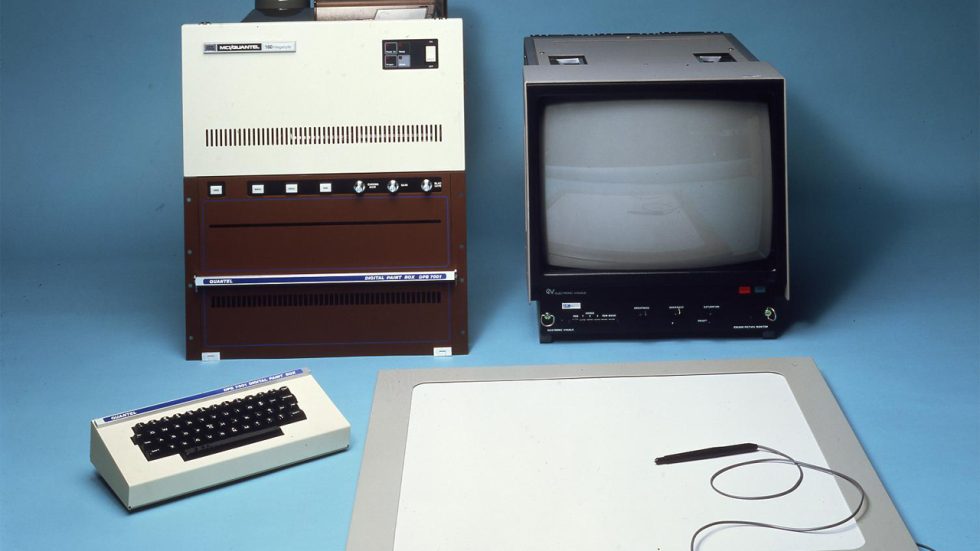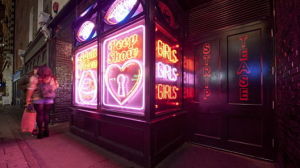


For 12 years, McGee worked out of this room, painting onto the screen, his eyes left bloodshot and burning from the smoke as runners dashed in and out to empty overflowing ashtrays. It was a painstaking process; the Quantel Paintbox and its pressure-sensitive stylus were groundbreaking pieces of technology when they were released in 1981, but they had their limitations. The huge 14-inch platter hard drive could store 160MB of data, enough for just over six seconds of video at 25 FPS. Longer pieces required playing out each frame to tape before wiping the hard drive, a risky process that resulted in McGee and his staff working eight-hour shifts around the clock to minimise cockups.
The Paintbox and its multi-frame follow up Harry—which could store up to 30 seconds of footage and manipulate multiple frames of animation at once—would come to dominate the TV industry throughout the 1980s and early '90s, defining the decade's iconic visual style (see Dire Straits' "Money For Nothing" video). It would even star in its own TV show on the BBC, Painting with Light, alongside artists like David Hockney. And for McGee, a graduate of the famous Central Saint Martins College of Art and Design, the Paintbox would spark a career in the visual effects industry spanning nearly three decades.
Framestore, the company he cofounded with Sir William Sargent in 1986, is the VFX house behind Walking with Dinosaurs, Guardians of the Galaxy, and Gravity, to name but a few. Framestore's sizeable reputation has seen it expand to New York, Los Angeles, and Montreal, but its home in London remains surprisingly understated. Tucked behind Oxford Street in a now-gentrified Soho, it's easy to miss amongst the Starbucks and sandwich shops lined up along the street, now the once-burgeoning sex shops have been pushed back to a sliver of real estate several streets away.
To walk through Soho now is to see rows of upscale restaurants boasting Michelin stars and overflowing wait lists, and bars and clubs that cater to London's post-shopping partiers. On these same streets, though, Hollywood's most memorable moments are created. Framestore is perhaps Soho's most famous VFX inhabitant, yet just a few streets away is MPC, whose work has featured in everything from PlayStation 4 and IKEA adverts, through to blockbuster films like The Hunger Games: Mockingjay Part 2, Batman v Superman: Dawn of Justice, and Spectre.
On Great Portland Street is Double Negative, which created sequences for both Inception and Interstellar, while over on Shaftesbury Avenue is the UK arm of Industrial Light & Magic, which at one point was hard at work on Star Wars: The Force Awakens. Renowned VFX plug-in developer The Foundry is just a short walk away, on Golden Square. Today there are well over 20 VFX production houses in London alone, with spending on film production in the UK reaching £1.47 billion in 2014. The VFX industry accounted for almost half of that money, with estimated revenues of £600 million—a far cry from the odd BBC title sequence produced out of that single, smoky room.
There are many reasons for the UK VFX industry's success. Ex-chancellor Gordon Brown introduced tax breaks in 1997, which allowed films that kept at least 10 percent of production in the UK to claim tax relief on up to 25 percent of their costs. Then there were the wildly popular Harry Potter films, which were all shot at Leavesden Studios in Hertfordshire, creating thousands of jobs and providing regular work for the nascent VFX sector.
But, more than any government intervention or blockbuster hit, it was the technological and home computing revolution of the '90s and '00s that cemented the future of VFX—and there was one company smart enough to bank its entire future on it.
reader comments
56